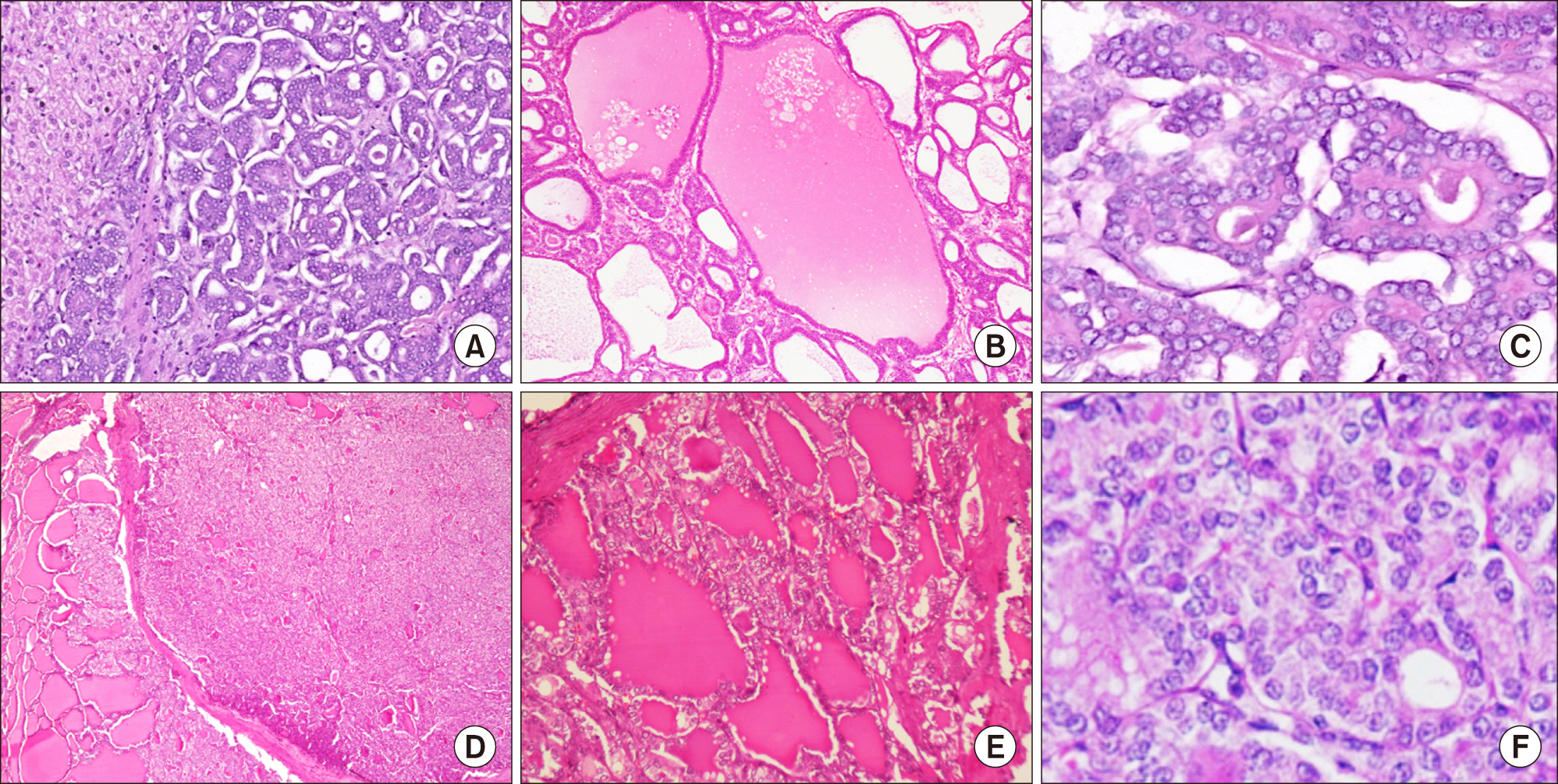Ann Hepatobiliary Pancreat Surg.
2020 May;24(2):182-187. 10.14701/ahbps.2020.24.2.182.
Pathologic Doppelgänger: Thyroid–like intrahepatic cholangiocarcinoma with synchronous primary thyroid carcinoma in a young woman
- Affiliations
-
- 1Departments of Pathology, Tata Memorial Centre, Mumbai, India
- 2Departments of Surgical Oncology, Tata Memorial Centre, Mumbai, India
- KMID: 2500803
- DOI: http://doi.org/10.14701/ahbps.2020.24.2.182
Abstract
- Intrahepatic cholangiocarcinoma (ICC) accounts for 8-10% of all malignant liver tumors. Preponderance for elderly males and occurrence of varied morphological patterns in ICC is well known. Recent reports have described a newly recognized variant of thyroid-like cholangiocarcinoma. Herein, we present a hitherto unreported synchronous occurrence of an intrahepatic thyroid-like cholangiocarcinoma and a separate thyroid carcinoma in a 23-year-old post-partum woman. Both tumors displayed striking resemblance to follicular variant of papillary thyroid carcinoma (FVPTC) however exhibited disparate immunohistochemical profiles: the intrahepatic tumor was positive for CK7 and CK19, and negative for TTF-1, PAX-8 and thyroglobulin whereas, the thyroid tumor was positive for TTF-1, thyroglobulin and PAX-8. Young age, female proclivity, large mass at presentation and unique histology in thyroid-like ICC hint towards a distinctive subset of ICC. Awareness and recognition of this rare entity is essential, not only for accurate diagnosis, but also for gathering information on its biology and clinical behavior. Synchronous occurrence with a FVPTC is a challenging scenario that can simulate metastatic disease and mislead subsequent patient management. Whether morphologic similarity points to an underlying linkage between the two different tumors needs exploration.
Keyword
Figure
Reference
-
1. Hapke MR, Dehner LP. 1979; The optically clear nucleus. A reliable sign of papillary carcinoma of the thyroid? Am J Surg Pathol. 3:31–38. DOI: 10.1097/00000478-197902000-00004. PMID: 534382.2. DeLellis RA. 1993; Orphan Annie eye nuclei: a historical note. Am J Surg Pathol. 17:1067–1068. DOI: 10.1097/00000478-199310000-00014. PMID: 8372945.3. Michal M, Kacerovska D, Kazakov DV. 2013; Cribriform adenocarcinoma of the tongue and minor salivary glands: a review. Head Neck Pathol. 7 Suppl 1(Suppl 1):S3–S11. DOI: 10.1007/s12105-013-0457-9. PMID: 23821209. PMCID: PMC3712093.
Article4. Amin MB, Gupta R, Ondrej H, McKenney JK, Michal M, Young AN, et al. 2009; Primary thyroid-like follicular carcinoma of the kidney: report of 6 cases of a histologically distinctive adult renal epithelial neoplasm. Am J Surg Pathol. 33:393–400. DOI: 10.1097/PAS.0b013e31818cb8f5. PMID: 19047894.5. Chang SY, Fleiszer DM, Mesurolle B, El Khoury M, Omeroglu A. 2009; Breast tumor resembling the tall cell variant of papillary thyroid carcinoma. Breast J. 15:531–535. DOI: 10.1111/j.1524-4741.2009.00773.x. PMID: 19594763.
Article6. Fornelli A, Bondi A, Jovine E, Eusebi V. 2010; Intrahepatic cholangiocarcinoma resembling a thyroid follicular neoplasm. Virchows Arch. 456:339–342. DOI: 10.1007/s00428-009-0874-z. PMID: 20082203.
Article7. Chablé-Montero F, Shah A, Angeles- Ángeles A, Henson DE, Albores-Saavedra J. , Montante-Montes de Oca D. 2012; Thyroid-like cholangiocarcinoma of the liver: an unusual morphologic variant with follicular, trabecular and insular patterns. Ann Hepatol. 11:961–965. DOI: 10.1016/S1665-2681(19)31427-9. PMID: 23109464.
Article8. Foucar E, Kaplan LR, Gold JH, Kiang DT, Sibley RK, Bosl G. 1979; Well-differentiated peripheral cholangiocarcinoma with an unusual clinical course. Gastroenterology. 77:347–353. DOI: 10.1016/0016-5085(79)90291-9. PMID: 221305.
Article9. Barrera JR, Manalo LA, Ang FL. 2012; Papillary thyroid-type carcinoma arising from struma ovarii. BMJ Case Rep. 2012:bcr0320126145. DOI: 10.1136/bcr.03.2012.6145. PMID: 22787184. PMCID: PMC3417009.
Article10. Shaib Y, El-Serag HB. 2004; The epidemiology of cholangiocarcinoma. Semin Liver Dis. 24:115–125. DOI: 10.1055/s-2004-828889. PMID: 15192785.
Article11. Saha SK, Zhu AX, Fuchs CS, Brooks GA. 2016; Forty‐year trends in cholangiocarcinoma incidence in the U.S.: intrahepatic disease on the rise. Oncologist. 21:594–599. DOI: 10.1634/theoncologist.2015-0446. PMID: 27000463. PMCID: PMC4861366.
Article12. Roti E, degli Uberti EC, Bondanelli M, Braverman LE. 2008; Thyroid papillary microcarcinoma: a descriptive and meta-analysis study. Eur J Endocrinol. 159:659–673. DOI: 10.1530/EJE-07-0896. PMID: 18713843.
Article
- Full Text Links
- Actions
-
Cited
- CITED
-
- Close
- Share
- Similar articles
-
- Coexistence of Parathyroid and Papillary Thyroid Carcinoma
- Synchronous thyroid carcinoma and squamous cell carcinoma: A case report
- A Case of Coexistence of Parathyroid and Papillary Thyroid Carcinoma
- A Case of Synchronous Double Primary Cancer of Gastric Adenocarcinoma and Thyroid Papillary Carcinoma
- Synchronous Occurrence of Papillary, Follicular, and Medullary Carcinoma in the Same Thyroid Gland



